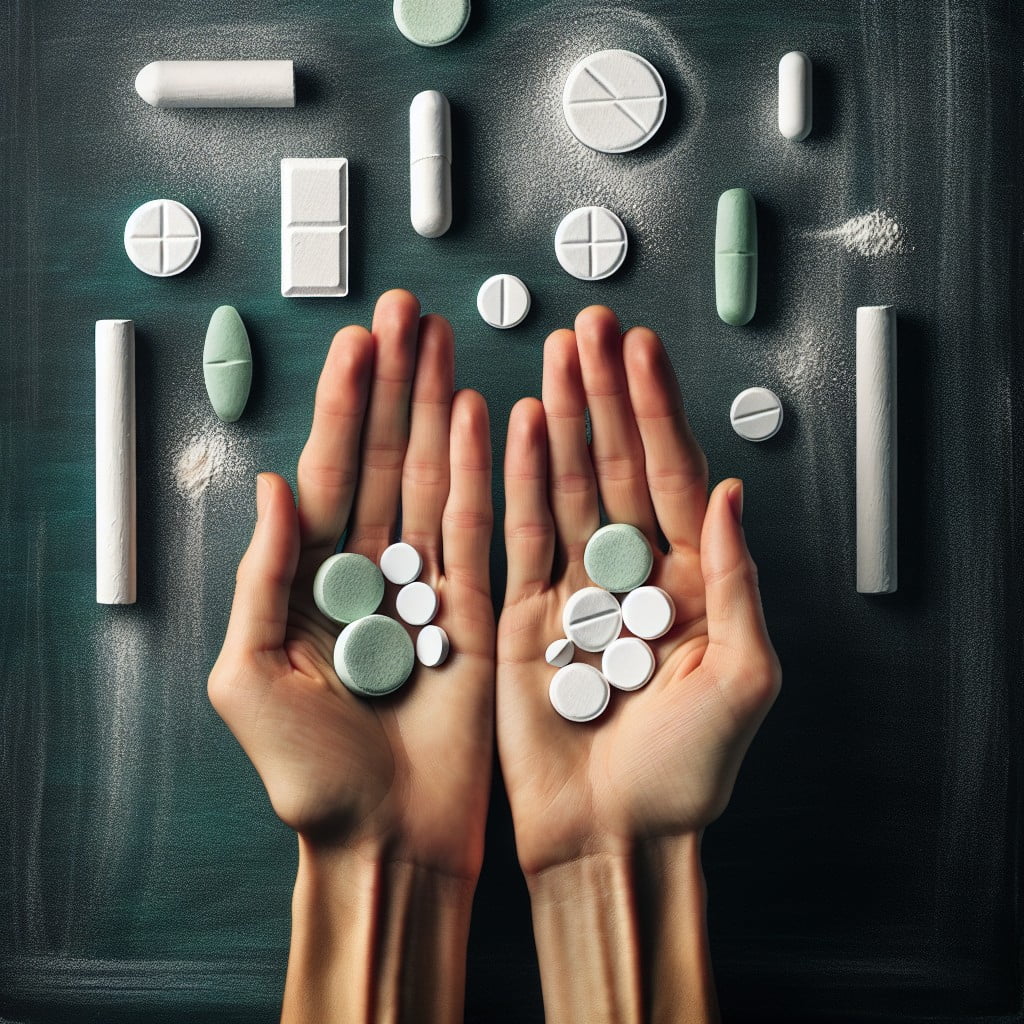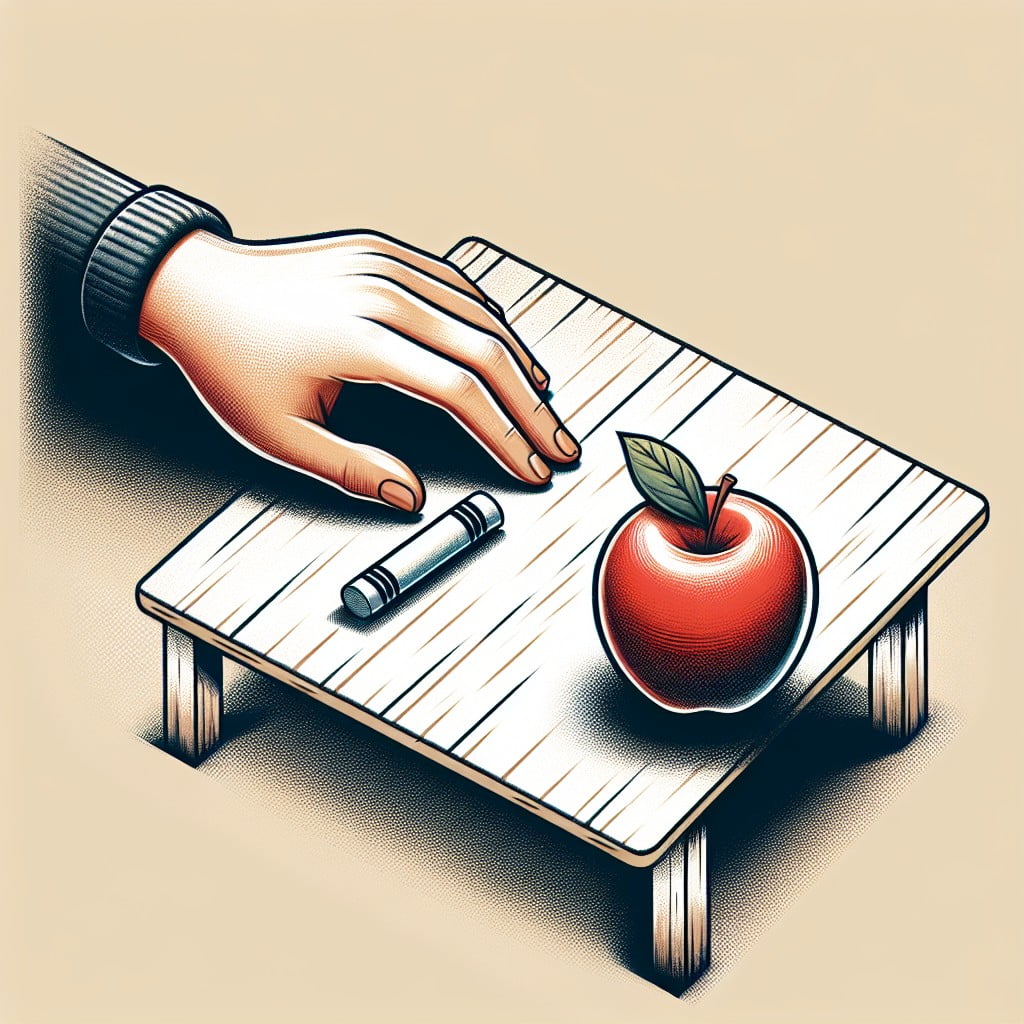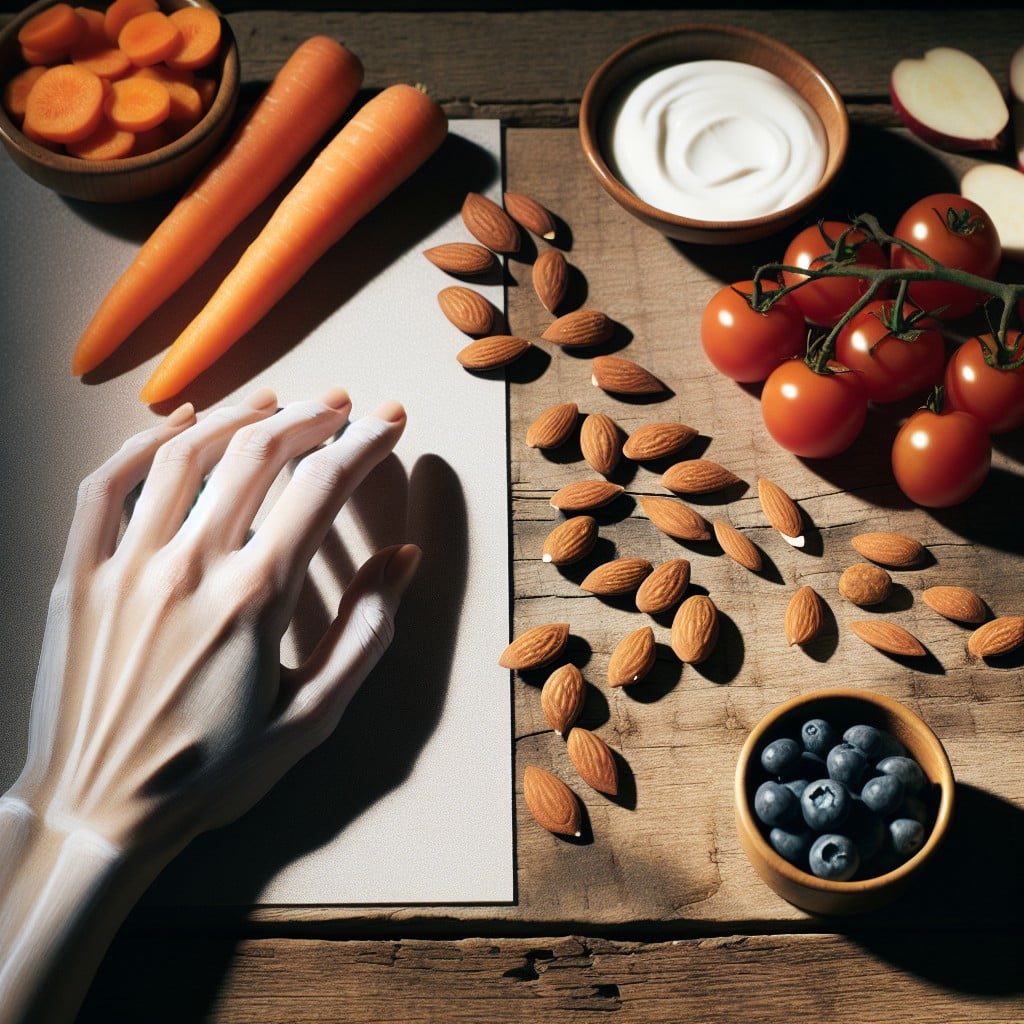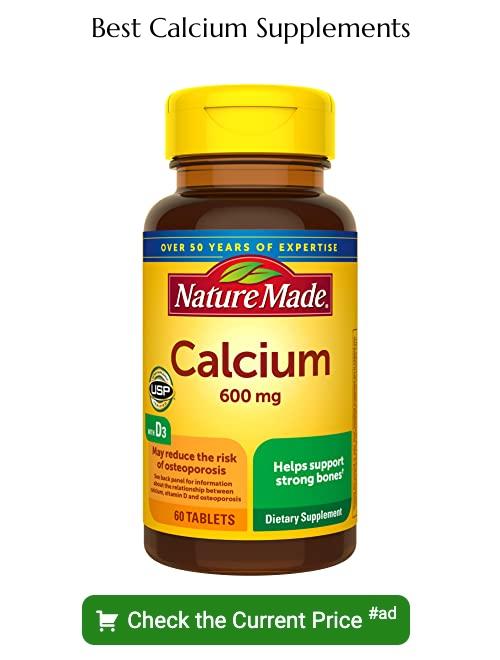Last updated on
Diving into the peculiar topic of eating chalk, this article will unravel the reasons behind this unusual behavior and its potential health implications.
Key takeaways:
- Nutritional deficiencies can trigger the desire to eat chalk.
- Mental health conditions like stress and OCD can contribute to chalk consumption.
- Cultural influences and food insecurity are also factors.
- Pregnant women may experience cravings for chalk.
- Eating chalk can lead to health complications and should be addressed.
Why Do People Eat Chalk?

Chalk consumption, a behavior often associated with the disorder pica, can be attributed to several reasons:
Understanding these triggers can help in addressing the root causes of chalk eating and formulating an effective intervention strategy.
The Role of Nutritional Deficiencies

Nutritional deficiencies can trigger unusual cravings, like the desire to consume chalk, a behavior linked to a condition known as pica. The lack of certain minerals, such as calcium, iron, and zinc, often underlies this compulsion. When the body is missing key nutrients, it may send signals that lead individuals to seek out alternative sources, sometimes in the form of non-nutritive substances.
Calcium deficiency, for instance, is prevalent during pregnancy, a time when some women report cravings for chalk, possibly as their body seeks to replenish the mineral for fetal development. Iron deficiency, another common trigger, can prompt similar cravings; it’s essential to transport oxygen in the blood and support metabolic functions. Zinc plays a critical role in immune function and cellular metabolism, and shortages of this mineral may also influence the development of pica.
It’s crucial to identify these deficiencies through medical testing, as they can have broader health implications beyond pica. A healthcare provider can determine the necessary interventions, such as dietary adjustments or supplementation, to address deficiencies and mitigate the urge to eat non-food items like chalk.
Mental Health and Chalk Eating

Chalk eating, which might seem an unusual habit, can occasionally be linked to mental health conditions. It’s important to address these aspects sensitively:
Emotional Regulation: For some, consuming chalk may serve as a coping mechanism to mitigate stress, anxiety, or emotional distress. The act of eating non-food items provides a temporary sense of relief or control in a person’s life.
Obsessive-Compulsive Tendencies: The compulsion to eat chalk could be a manifestation of an obsessive-compulsive disorder, where a person feels a strong urge to perform specific unusual behaviors.
Developmental Disorders: Individuals with developmental disorders, such as autism spectrum disorders, might exhibit pica, including a craving for chalk, as part of their behavioral patterns.
Association with Other Disorders: Sometimes, the drive to eat chalk can be associated with other mental health disorders that include disordered eating patterns or poor impulse control.
In each case, understanding the mental health context is crucial for effective intervention and treatment. Mental health professionals can offer targeted therapies to address both the behavior and its underlying emotional triggers.
Cultural Perceptions of Eating Chalk

In some cultures, the practice of consuming chalk, referred to as geophagy, is a traditional phenomenon with historical roots. For example:
- In parts of Africa, chalk is often consumed by pregnant women who believe it will satisfy cravings and supply them with vital minerals.
- Among certain Native American tribes, kaolin clay, a type of chalk, has been eaten for centuries for its supposed detoxifying properties.
- It is not uncommon in rural areas of Eastern Europe for chalk to be used as a folk remedy for gastric upset.
Despite its presence in various traditions, it’s essential to note that such practices do not equate to a blanket endorsement of safety. Medical professionals usually advise against the consumption of non-food items, including chalk, due to potential health risks.
Food Insecurity and Cravings for Non-Food Items

In areas where food scarcity is prevalent, the body’s cry for nutrients can manifest in unexpected ways. Those experiencing food insecurity may develop an urge to consume non-food substances—a condition tied to pica. The persistence of hunger and the body’s desperation for minerals can lead to an individual seeking out substances like chalk, which can mimic the sensation of consuming solid food, albeit without providing nutrition.
Historical accounts and ongoing research suggest that the craving for such items often correlates with iron and zinc deficiencies, even though chalk does not alleviate these deficits. Understanding the link between nutrient insufficiency and these cravings is important for developing effective interventions that address the root cause—improving access to and the quality of diet.
Signs of PICA
Identifying the patterns of PICA involves paying close attention to unusual eating behaviors that persist over time. If someone routinely consumes non-food items such as chalk, it may indicate this condition. The craving to eat such substances is often a clear sign.
Physical symptoms also serve as indicators. For instance, if an individual is experiencing stomach pain or dental issues without a clear cause, it could suggest the ingestion of non-nutritive substances. Stools containing pieces of non-digestible matter also point towards this eating disorder.
Medical attention is necessary when a person shows persistent interest in consuming non-food items, particularly if they cannot control these urges or if they interfere with their daily functioning. If a child displays these behaviors, it’s imperative to consult a pediatrician to explore the reasons behind their actions.
Recognizing Behavior Patterns

Identifying consistent consumption of non-food items is key to recognizing behavior patterns associated with pica. Family members or caregivers should pay attention to the following indicators:
- Frequent ingestion of substances like chalk, which have no nutritional value
- Preference for specific textures or types of chalk
- Secretive or compulsive eating of non-food items
- Persistent cravings lasting longer than a month
- Social or functional impairment due to these eating habits
Early detection can prompt timely intervention, reducing potential health risks and improving the individual’s quality of life. If such patterns are noticed, consulting a healthcare provider is critical to address the behavior and explore underlying causes.
Physical Symptoms Indicative of PICA
Persistent consumption of non-nutritive substances like chalk may lead to a host of physical symptoms that should raise concern. These include:
- 1. Dental problems: Abrasive materials can wear down tooth enamel, potentially causing sensitivity or cavities.
- 2. Constipation or diarrhea: Chalk can disrupt the normal function of the digestive system, leading to irregular bowel movements.
- 3. Abdominal pain: Foreign materials can irritate the stomach and intestines, resulting in discomfort or cramping.
- 4. Intestinal obstruction: Large quantities of indigestible material can accumulate and block the intestines, a serious condition that may require medical intervention.
- 5. Malnutrition: An imbalanced diet devoid of essential nutrients can result from the displacement of regular food with non-food items.
- 6. Lead poisoning: Chalk not intended for consumption may contain lead or other toxic substances harmful to the human body, presenting with symptoms such as headaches, fatigue, or learning difficulties.
Monitoring for these symptoms can be crucial in identifying and addressing PICA early. If any of these signs are present, consulting a healthcare provider is highly recommended.
When to Seek Medical Attention
If you or a loved one are experiencing a craving to eat chalk, it’s essential to be vigilant about when it’s time to seek professional help. Consult a healthcare provider if:
- The desire to consume chalk persists for more than a month, indicating a potentially chronic condition.
- Consuming non-food items becomes a preferred choice over regular meals or nutrition-rich foods.
- There is noticeable physical distress, such as stomach pains, tooth issues, constipation, or diarrhea.
- You observe developmental delays or behavioral changes in children, which could suggest nutritional deficiencies or an underlying psychological condition.
- There’s a known risk of exposure to harmful substances due to ingesting chalk not intended for consumption, such as chalk with lead or other toxins.
Prompt medical attention can help address the underlying causes and prevent further health complications.
Side Effects of Eating Chalk
While the urge to eat chalk might seem benign, indulging in this craving can lead to several health complications. Chewing on it can wear down dental enamel, increasing the risk of cavities and tooth decay. Additionally, as the digestive system is not designed to process chalk, consumption could lead to digestive distress, constipation, and, in severe cases, bowel obstruction.
Furthermore, impurities and contaminants found in chalk, such as lead or other harmful chemicals, could pose a significant risk, especially with prolonged exposure. These toxins can accumulate in the body, potentially leading to poisoning or other serious health issues.
Pregnant women should be particularly cautious, as eating non-food substances could interfere with nutrient absorption, jeopardizing fetal health and development. Therefore, it’s essential to seek alternatives and address the root cause of the craving to avoid these adverse effects.
Dental Damage
Chewing on chalk can lead to several oral health issues due to its abrasive nature. Enamel erosion ranks high among them; constant grinding against the hard substance wears down the protective outer layer of teeth. Without this enamel shield, teeth become susceptible to cavities and decay.
Moreover, the brittleness of chalk can cause chips and fractures, especially in those who bite down with significant force. These breaks in the tooth’s structure create entry points for bacteria, possibly leading to infections or abscesses without prompt dental care.
In addition, the repetitive motion required to consume chalk places a strain on the temporomandibular joint (TMJ), which can, over time, result in jaw pain, headaches, or even the development of temporomandibular disorder (TMD). Lastly, a less discussed but important aspect is the potential for chalk to contribute to gum inflammation and disease, as residual particles can irritate delicate gum tissues.
Digestive Issues and Bowel Obstruction
Chalk consumption can lead to a raft of digestive problems, starting from minor discomfort to severe cases of bowel obstruction. Chalk’s non-digestible nature means that it doesn’t break down easily in the stomach or intestines. This can result in:
- Constipation: As an indigestible substance, chalk can clog up the digestive tract, leading to difficulty in bowel movements.
- Impaction: Over time, chalk particles can aggregate, forming larger masses. These can become lodged in the intestines, preventing waste from passing through.
- Perforation: In extreme cases, the build-up of chalk could puncture the intestinal wall, an emergency condition that requires immediate medical intervention.
- Altered bowel habits: Individuals may experience changes in the frequency or consistency of their stools. It’s important to monitor for any developments that deviate from one’s normal patterns.
Promptly addressing these symptoms can help prevent more serious complications. If any digestive changes occur after consuming chalk, it is crucial to seek medical advice.
Exposure to Toxins
Chalk from natural sources often contains traces of heavy metals like lead and mercury. Regular consumption can lead to a buildup of these toxic substances in the body. This accumulation can cause a range of health problems, including damage to the nervous system, which might manifest as headaches, cognitive impairments, or behavioral issues.
Moreover, chalk products not intended for consumption may harbor other harmful chemicals and contaminants. Manufacturers might add substances to enhance the chalk’s texture, color, or durability, not considering the implications for human health if ingested.
Furthermore, eating chalk can interfere with nutrient absorption, resulting in mineral deficiencies despite an adequate diet. This disruption is due to the presence of antinutrients in chalk, which bind to minerals and prevent their proper assimilation in the digestive system.
The potential for exposure to toxins underscores the importance of reaching out to healthcare professionals if an individual is compelled to eat chalk. They can assess for toxicity and provide guidance on avoiding these harmful substances, helping maintain overall health and well-being.
Impact On Fetal Growth and Development
Consuming chalk during pregnancy can pose risks to both the mother and the unborn child. Here are some ways in which this unusual habit might affect fetal growth and development:
Interference with Nutrient Absorption: Chalk, largely composed of calcium carbonate, could potentially disrupt the absorption of essential nutrients like iron and zinc, which are vital for the baby’s growth.
Toxin Exposure: Some types of chalk contain contaminants such as lead, which can be harmful to the developing nervous system of the fetus, increasing the risk of birth defects and cognitive issues.
Increased Health Complications: A diet inclusive of non-food items can lead to maternal complications such as anemia or bowel obstructions, resulting in decreased oxygen and nutrient flow to the fetus, impairing proper development.
Calcium Overload: Though calcium is necessary for fetal development, excessive amounts can cause an imbalance in maternal and fetal electrolytes, which might have adverse effects on fetal heart rate and muscle function.
Optimal fetal health depends on a balanced diet and avoidance of non-nutritive substances. Pregnant women with cravings for non-food items should consult healthcare providers for safe interventions.
How to Stop Eating Chalk?
Address any underlying nutritional deficiencies by consulting with a healthcare provider to determine if there’s a lack of minerals like calcium or iron in your diet. A tailored supplementation plan may be necessary.
Seek professional guidance from a psychologist or counselor, as therapy can be crucial in managing the compulsion to eat non-food items. Cognitive-behavioral therapy (CBT) is particularly effective in altering disruptive eating habits.
Engage in positive replacement behaviors when the urge to eat chalk arises. Chewing sugar-free gum or snacking on healthy alternatives like carrots can redirect the craving and provide oral stimulation without the harmful effects.
Maintain a structured eating schedule with nutritious, balanced meals which can help stabilize hunger and reduce the likelihood of seeking out non-nutritive substances.
For severe cases, medication may be prescribed to address underlying mental health issues or to reduce the obsessive desire to eat chalk. A psychiatrist can provide the appropriate medical treatment.
Stay disciplined in monitoring your condition. Keep a journal to track triggers and progress, which can offer insights into patterns and improvements over time.
FAQ
What does eating chalk do?
Eating chalk, while minimally toxic in small doses, can lead to significant disruption of the digestive system and potential harm to internal organs if consumed often.
Is it OK to eat a little bit of chalk?
While consuming small amounts of chalk is generally regarded as non-toxic, consuming large quantities can lead to stomach irritation and potential vomiting, noting that certain types such as pool or billiard chalk may contain harmful substances like lead.
Does chalk have calcium?
Yes, chalk does contain calcium, as it predominantly consists of calcium carbonate.
What is edible chalk reddit?
Edible chalk, often made from Gypsum (Calcium Sulfate) or Calcium Carbonate, is safe for consumption in small quantities and even provides some amount of Calcium to the body, which is why it is sometimes used as a dairy substitute in Tofu products.
Can chalk ingestion have health implications?
Yes, chalk ingestion can have health implications, including constipation, digestive discomfort, and possible poisoning due to harmful substances sometimes found in chalk.
What types of chalk are considered edible?
Edible chalk types involve natural chalk from regions like Belgorod, Sawn Belgorod, and Vratsa or products specifically designed for consumption such as food-grade chalk.
Is there a connection between pica disorder and chalk consumption?
Yes, there is a connection between pica disorder and chalk consumption as pica is characterized by an appetite for non-nutritive substances including chalk.
Recap:





